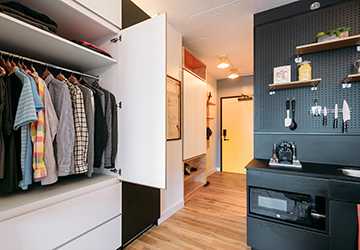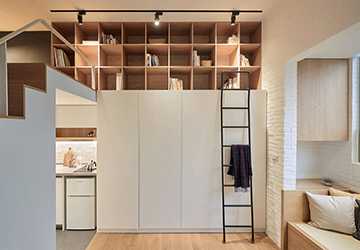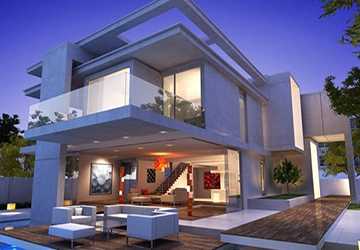Urban landscapes have always been the hallmark of change. The skyscrapers that pierce the clouds today were once inconceivable, just as suburban sprawls once seemed like the only solution to a growing population's housing needs. Yet, a new movement is taking the urban jungle by storm – the micro apartment trend. This latest shift in urban living changes offers a fresh perspective on what it means to live in a city, highlighting the benefits of compact, efficient living. Let’s dive into the appeal and growing popularity of these compact housing solutions.
The Rise of the Micro Apartment Trend
The micro apartment trend isn't just a fleeting whim but a response to evolving societal needs. As cities become more crowded and real estate prices skyrocket, there's an increasing demand for affordable and efficient housing solutions. This is where the micro apartment comes in: small living units, typically under 400 square feet, optimized for maximum efficiency without sacrificing comfort.

Benefits of Small Living Spaces
The idea of living in a smaller space might seem restrictive to some, but the benefits of small living spaces are manifold:
‾ Economic Efficiency: With rising housing prices, micro apartments present an affordable option for many urban dwellers. Reduced rental costs mean more money in the pocket and less financial stress.
‾ Sustainability: Smaller spaces equate to reduced energy consumption. These homes often incorporate green technologies and designs, further minimizing their ecological footprint.
‾ Simplicity: Embracing the micro apartment trend means embracing a simpler lifestyle. Fewer belongings lead to less clutter, making cleaning and maintenance a breeze.
‾ Community Living: Many micro apartment buildings foster a sense of community. Shared amenities like lounges, kitchens, and rooftop gardens encourage social interaction.
Urban Living Changes: Adapting to the Times
It's evident that urban living changes are not just about architecture but also societal shifts. As the world becomes more interconnected and digital, there's less need for sprawling spaces. Remote work, digital entertainment, and online shopping have diminished the necessity for larger living quarters.
Moreover, there's an increasing desire among the younger generation to live closer to urban centers. Being in proximity to workplaces, entertainment hubs, and cultural landmarks outweigh the allure of spacious suburban homes for many.
Compact Housing Solutions: Beyond Just Micro Apartments
While micro apartments are at the forefront, other compact housing solutions are also emerging. Co-living spaces, where individuals have private bedrooms but share common areas, are gaining traction. These spaces foster community, collaboration, and shared responsibilities, emphasizing the societal shift towards collective living.
The Future of Urban Living
As cities continue to grow and evolve, the demand for efficient, affordable housing solutions will only increase. The micro apartment trend and other compact living arrangements are not just trends but indicative of broader urban living changes. They represent a future where city dwellers can find balance – enjoying the hustle and bustle of city life without being burdened by exorbitant housing costs or excessive living spaces.
Maximizing Space in Micro Apartments
One of the most fascinating aspects of the micro apartment trend is the innovation in space utilization. Here’s how these spaces are being transformed:
● Multifunctional Furniture: Think of beds that fold into desks or couches that double as storage. These pieces ensure that every inch serves a dual purpose.
● Vertical Solutions: From wall-mounted desks to hanging planters, using the vertical space effectively is a staple in compact housing solutions.
● Open Layouts: Fewer walls mean a more expansive feeling, even in smaller areas.
The Role of Technology in Compact Living
The embrace of urban living changes goes hand in hand with advancements in technology:
● Smart Home Integration: Modern micro apartments often incorporate smart home systems, from lighting to temperature control, ensuring efficiency and comfort.
● Space-saving Gadgets: From compact kitchen gadgets to slimline entertainment systems, technology is catering to the needs of smaller living spaces.
Design Philosophies Behind Micro Apartments
Incorporating function and aesthetics into a limited space is an art. Some design approaches include:
● Light and Reflection: Using light colors, mirrors, and strategic lighting to create the illusion of a more spacious area.
● Zone Division: Designating specific areas for different functions – a corner for work, a cozy nook for reading, etc.
● Incorporating Nature: Even in small spaces, the inclusion of greenery, whether through potted plants or vertical gardens, can provide a sense of openness.

The Psychological Impact of Micro Living
Understanding the benefits of small living spaces is not just about the tangible:
● Mental Clutter Reduction: A smaller space often leads to fewer possessions, reducing distractions and promoting mental clarity.
● Enhanced Creativity: Limited spaces challenge residents to be creative in decorating and utilizing their surroundings.
● Sense of Coziness: For many, smaller spaces can foster a feeling of coziness and security, a concept known in Danish culture as "hygge."
Challenges and Critiques of Micro Living
While there are numerous benefits of small living spaces, it's essential to also address the challenges:
● Feeling of Crampiness: Not everyone adapts well to limited space. Without the right design, small spaces can feel claustrophobic.
● Limited Storage: One has to be creative and selective about belongings in micro apartments.
● Noise Concerns: In some buildings, thinner walls and closer quarters can mean less privacy.
Embracing Minimalism with the Micro Apartment Trend
The rising popularity of the micro apartment trend is not just a housing shift but also reflects a broader cultural move towards minimalism:
● Reduced Consumption: Living in a smaller space often leads to consuming less and buying only essential items.
● Mindful Living: Such spaces encourage residents to be more intentional about their surroundings and their life choices.
● Less is More Philosophy: This age-old concept is being redefined and rediscovered through urban living changes.
Conclusion
The evolution of urban habitats, led by the micro apartment trend and other compact housing solutions, is an insightful reflection of societal adaptations. The modern dweller is looking for convenience, sustainability, and affordability, and micro apartments cater precisely to these needs. By addressing both the advantages and the challenges of this trend, we can better appreciate its significance in the ever-changing urban tapestry. As cities burgeon and space becomes a premium, these housing solutions, in conjunction with technological advances, will undoubtedly shape the urban landscapes of tomorrow.


